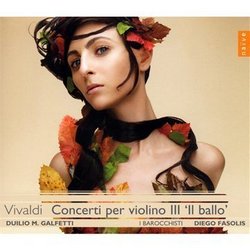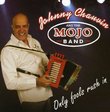| All Artists: Galfetti, I Barocchisti, Fasolis Title: Vivaldi: Concerti per Violino 3, "Il ballo" (Vivaldi Edition) Members Wishing: 1 Total Copies: 0 Label: Naive Original Release Date: 1/1/2009 Re-Release Date: 3/31/2009 Genre: Classical Styles: Chamber Music, Forms & Genres, Concertos, Historical Periods, Classical (c.1770-1830) Number of Discs: 1 SwapaCD Credits: 1 UPC: 709861304745 |
Search - Galfetti, I Barocchisti, Fasolis :: Vivaldi: Concerti per Violino 3, "Il ballo" (Vivaldi Edition)
 | Galfetti, I Barocchisti, Fasolis Vivaldi: Concerti per Violino 3, "Il ballo" (Vivaldi Edition) Genre: Classical The third volume of violin concerti these with a theme, 'Il Ballo' in reference to the strong dance influence apparent in these particular concertos. Diego Fasolis' strong sense of rhythm coupled with the fluidity and vi... more » |
Larger Image |
CD DetailsSynopsis
Album Description The third volume of violin concerti these with a theme, 'Il Ballo' in reference to the strong dance influence apparent in these particular concertos. Diego Fasolis' strong sense of rhythm coupled with the fluidity and virtuostic ease of Galfetti's playing render this cd irresistible. The Vivaldi Edition: a recording venture conceived by the Italian musicologist Alberto Basso and the independent label Naïve, is one of the most ambitious recording projects of the twenty-first century. Its principal objective is to record the massive collection of Vivaldi autograph manuscripts preserved today in the Biblioteca Nazionale Universitaria in Turin, some 450 works in all. This treasure trove is none other than the private library of scores Vivaldi had at home at the time of his death in Vienna in 1741 and includes his extant operas, hundreds of concertos, sacred compositions and cantatas. After a chaotic itinerary which took them from Venice to Genoa, then to Casale Monferrato in Piedmont, these manuscripts ended up almost by accident at the library in Turin, which, realising their priceless value, managed to acquire them around 1930 thanks to two generous patrons. The collection includes fifteen operas and several hundred concertos, as well as sacred compositions and secular cantatas. Most of this music has not been heard since the eighteenth century. The release of more than one hundred recordings, which began in the year 2000, will continue until 2015. The Vivaldi Edition's goal is to make this extraordinary wealth of music available to the public and at the same time to reveal the full genius of Vivaldi, not only as a composer of instrumental music, for which he was already known, but as the creator of some of the eighteenth century's most important vocal music. Beyond the realm of recording, the Vivaldi Edition is active in promoting affiliated concerts in major festivals and concert series throughout Europe and in developing multimedia projects which bring together musicians, film-makers, authors, visual artists and others. Similar CDs
|
CD ReviewsMore Great Violin Concerti Andrew Judkins | 07/31/2009 (5 out of 5 stars) "Naive's last release of Vivaldi violin concerti was titled Di Sfida and used challenging virtuosity as its theme. While one could argue this virtuosity is a strong aspect in almost all Vivaldi's concerti, Di Sfida was truly a collection of exceptionally difficult works. The same can be said of this collection titled Il Ballo; almost all of Vivaldi's work have a strong dance influence and a vivid sense of movement. The odd thing is that there seems to be no particularly strong dance influence in these works when compared to any concerto by Vivaldi. The theme isn't wrong, its just hidden. Vivaldi used dance ideas, rhythmic drive and popular and folk music as influences in all his music. Despite this weaker connecting theme, this disc has strange periphery connections. The works here tend to have extra strong 3rd movements, artistically. Four movements in three works have fugues or fugatos in the ritornelli. Six of the seven works are in major keys, a higher percentage than in Vivaldi's catalogue. This collection of works seem to have especially attentive orchestral writing as well. Lastly, these concerti seem to share a certain odd freshness. To me, these connections stand out more than the omnipresent dance influence. It is a collection of outstanding and little known works that reveal new sides of Vivaldi. Duilio Galfetti provides energetic solo work with a great sense of articulation. I Barocchisti provides enthusiastic playing of the lush orchestral writing. The works included are: RV 352 in A major. This concerto is short and vivid, a reminder of Vivaldi's sharp sense of economy. The slow movement is a fantastic melody of the most gentle kind. Both outer movements are clever and entertaining torrents of notes, with the first movement, unusually, being the wilder. RV 307 in G major. More ambitious, this concerto moves between rustic effects and reflectiveness. The slow movement has a slight sense of dread running through the innocent beauty. The finale starts with a fugato and to add a drama, the solo enters in a minor key, a device repeated at the start the last solo. The rest of the movement is exceptionally clever for a concluding movement. RV 268 in E major. This work is full of character. The first movement is gentle, using a jazzed up version of Il riposo (RV 270) as it's theme. Though this is the kind of gentleness Vivaldi often used for E major, a strong rustic element is also found, bringing to mind Spring from the Four Seasons. The slow movement carries this rustic idea with a wonderful lilting violin melody. The finale is one of Vivaldi's most immediately striking movements. It features a 'chase' effect where the violins imitate each other in very close proximity. Though often used by Vivaldi to symbolize dawn, this feature, here, is used to create a country stomp. As if Vivaldi was so enamored by this movement that he didn't want to stop, he includes a violin cadenza before the last ritornello as a way to extend inspiration. RV 333 in G minor. This work is pensive and at times stormy. It is one of Vivaldi's masterpieces and great care was apparently taken in its writing. The first movement is thoughtful and full of contrasts. The slow movement is desolate with a strange theme in the orchestral violins. To conclude Vivaldi turns to a fugue-based movement of extreme vigor. Toward the end the soloist plays violent torrents of notes as the fugue recapitulates. RV 210 in D major. This work is also the famous opus 8 number 11, but this version is a variant. For some reason Vivaldi rearranged this work over and over. This version is more virtuosic than the published one, but not necessarily better, artistically. An odd feature is the 'stealing' of a sequence from the much earlier concerto, Il grosso mogul (also in D major). RV 312 in G major. This work has a rustic basis also, mixing lyrical elements in effectively. The slow movement has a strange 'chattering' effect in the orchestra, making jolly out of a very lyrical solo. The last movement is surprisingly mysterious, though still extroverted. RV 350 in A major. This work has an unusual sense of grandeur compared to others in this set. The style suggests a late composition date. The almost cocky first movement theme is taken up by the violin to open the first solo. The slow movement has the orchestra playing pizzicato as the foundation of a romantic solo. The last movement is fairly gentle with a hypnotic canon in the violins. The soloist responds with a shot of vigor to offset the dreamy mood of the orchestra." Infectious Jon Chambers | Birmingham, England | 02/21/2010 (5 out of 5 stars) "Vivaldi devotees, especially those seeking novelty, have been supremely well served lately. First, Gli Incognito's 'Les quatre saisons', which featured two exceptional (?)late violin concerti as 'bonus tracks'. Then two CDs from Naïve: New Discoveries, including a beautiful concerto for oboe and bassoon; and now this one, Il Ballo (The Dance), offering no less than seven violin concerti, most of them unheard since the C18! Not since the advent of Carmignola and his 'Late Violin Concertos' (Sony) has the world of Vivaldi seemed so vibrant.
Olivier Fourés, writing the liner notes, highlights three concerti as being of particular interest - RV210, RV333 and RV310 - while the rest, he thinks, are of 'less stature'. But one of the triumphs of this set is that there is something highly engaging about all of them. Even the supposedly lesser works delight the listener with their quirky charms and their (often dance-like) exuberance. Take, for instance, the Concerto in E, RV268. While possessing, arguably, no great melody or striking rhythmic features, it effortlessly expresses joie de vivre - assisted by charismatic and perceptive playing by soloist Duilio Galfetti, for whom music is clearly more than dots on the page. His willingness to show his own musical personality and wit (in much the same manner as Biondi) certainly adds variety and interest to works which could sound routine in other hands. Likewise the playing of I Barocchisti - equally willing to show creative engagement (the unexpected tremolo effect they conjure up in the closing cadence of RV352's Largo matches the soloist's skittishness in the closing cadence of RV350's final Allegro). The recording, meanwhile, is unimpeachable. And the 'dance' theme? Does the term really lend coherence to these concerti? In some ways, yes. As Fourés points out in his interesting essay, 'Eighteenth-century Swing', Vivaldi's humble background gave him an intimate knowledge of the more popular music of the time, with its abundant dance rhythms. The whirling final Allegro of RV333 in g has something of the possessed tarantella about it. He could also have said that Vivaldi's first published works were two volumes of violin sonatas, and these sonatas invariably included dance types - usually in two of their four movements (Giga, Sarabande, Allemande, Corrente and Gavotta being the most common, in their Italian forms). So, here and elsewhere, Vivaldi had a dance-beating pulse very much in his blood. It is an inescapable feature of his music generally, not just on this CD, that helps to account for his ever-growing popularity. All in all, this new recording somehow manages to surpass New Discoveries and, for me, is easily the best volume of Violin Concerti from Naïve to date. Featuring so much first-rate - albeit unknown - music, it is one I would not want to be without for long." |



